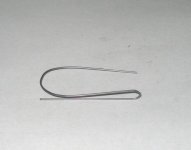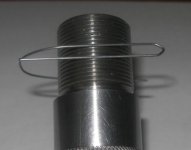Boyd Allen
Active member
Some time back, I put up a question asking for tips on the use of thread wires. I got a lot of very good help, and saved that whole thread on my computer. One of those suggestions caught my eye. It involved bending a single piece of music (AKA piano) wire so that it touches a tenon thread in all the same places as properly placed individual thread wires would, and holds itself in place, leaving two hands to run the micrometer. That, I liked. Before you tool and die guys start to guffaw too loudly, or become physically ill, let me explain. First thing, I am not springing for a set of full on dead nuts thread wires. I know that the tolerance for tenon thread fit do not require it, I'm on a budget, AND as long as I am making comparisons between an existing tenon (that fits my action) and threads that are being cut on a replacement barrel, using the over the wires measurements (as opposed to converting to pitch diameter which is entirely unnecessary in this situation) any dependencies in wire diameter will not matter, as long as they are reasonably long and uniform. Bottom line, my $20 Chinese made set should work just fine, EXCEPT that using them requires some degree of three (or four) handedness, or some slightly advanced guile, and practice, which virtually guarantees that I will be dropping wires repeatedly, and becoming more proficient with profanity ( if that is possible) that measuring with thread wires. Not good. This is why the one bent wire that holds itself in place idea was so attractive to me. So, after forgetting to stop at the well stocked hobby store that is a half hour away, numerous times, yesterday, my one track mind finally jumped its track, and I remembered that I needed to stop at the hobby store, just as I was approaching it, at a time when I had the time to stop. They had a package of four pieces of 36" long .032 music wire, for the princely sum of under $3. I was in, out and on my way in less than 5 minutes, with two more important checks to make, diameter, uniformity,and roundness. After arriving at home, I got out my .001 mic, and it passed with flying colors. It was a little notchy as I spun it in the mic, but the out of round was probably less than .0001. and The diameter was closer to spec. than the cheap Chinese thread wires. This evening, I used my diagonal pliers to cut a piece about a foot long, and got to bending. The next one that I make will be better, but this one works just fine. I made it 4" wide so that it would have enough flexibility to align into the threads, clipped it on a tenon, and used two hands on my 1-2" mic. It was easy, which was the idea. I was going to take a picture and insert it in this post but it is getting late, and the camera batteries need charging. Perhaps tomorrow. Comments?





